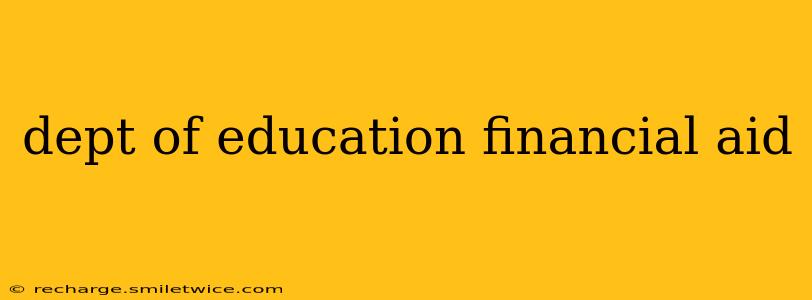Securing financial aid for higher education can feel like navigating a complex maze. The U.S. Department of Education (ED) is the primary source for federal student aid, offering various programs designed to make college more affordable. This comprehensive guide will demystify the process, providing you with the information you need to successfully apply for and manage your federal student aid.
What Types of Financial Aid Does the Department of Education Offer?
The Department of Education offers a range of financial aid options, broadly categorized as grants, loans, and work-study programs. Each has its own eligibility criteria and repayment terms.
-
Grants: These are essentially "free money" – funds you don't have to repay. Examples include Pell Grants and Federal Supplemental Educational Opportunity Grants (FSEOG). Eligibility is based on financial need, determined by the Free Application for Federal Student Aid (FAFSA).
-
Loans: These require repayment after graduation or leaving school, often with interest. Federal student loans come in various forms, including subsidized and unsubsidized loans, as well as PLUS loans for parents and graduate students. Interest rates and repayment plans vary depending on the loan type.
-
Work-Study: This program provides part-time employment opportunities to help students earn money to contribute towards their education expenses. Eligibility is based on financial need as determined by the FAFSA.
How Do I Apply for Federal Student Aid?
The cornerstone of applying for federal student aid is the Free Application for Federal Student Aid (FAFSA). This online application gathers information about your financial situation and uses it to determine your eligibility for various aid programs. Submitting the FAFSA is crucial, as it's the gateway to accessing federal grants and loans.
What is the FAFSA, and when should I complete it?
The FAFSA is a free application that determines your eligibility for federal student aid. The earlier you complete it, the better, as some financial aid is awarded on a first-come, first-served basis. The best time to complete the FAFSA is between October 1st and December 31st of each year, for the following academic year.
What information do I need to complete the FAFSA?
To complete the FAFSA accurately and efficiently, gather the following information:
- Social Security Number: Both yours and your parents' (if dependent).
- Federal tax returns: Yours and your parents' (if dependent).
- Driver's license: Optional, but can speed up the process.
- Bank statements: To verify financial information.
- Records of untaxed income: This includes things like child support.
What Happens After I Submit the FAFSA?
After submitting your FAFSA, your information is processed, and the results are sent to your chosen schools. Your school will then determine your financial aid package, outlining the types and amounts of aid you're eligible for. This package might include a combination of grants, loans, and work-study.
What are the Different Types of Federal Student Loans?
Federal student loans fall into several categories:
- Subsidized Loans: The government pays the interest while you're in school at least half-time, during grace periods, and during deferment.
- Unsubsidized Loans: Interest accrues from the moment the loan is disbursed, even while you're in school.
- PLUS Loans: These loans are available to parents of dependent students and to graduate students.
How Can I Manage My Student Loans?
Effective loan management starts with understanding your loan terms, including interest rates, repayment plans, and potential deferment or forbearance options. The National Student Loan Data System (NSLDS) is a valuable resource for tracking your loans and understanding your repayment responsibilities. Explore different repayment plans to find one that suits your budget and financial circumstances after graduation.
What Resources are Available for Help with Student Loan Repayment?
The Department of Education offers several resources to help borrowers navigate loan repayment. These include income-driven repayment plans, which adjust your monthly payments based on your income, and loan forgiveness programs for certain professions, such as teaching or public service. Contacting your loan servicer directly is crucial for understanding your repayment options and addressing any potential issues.
This guide offers a starting point for understanding the Department of Education's financial aid programs. Remember to carefully review the information provided by the Department of Education and your chosen institution to ensure you make informed decisions about financing your education. Always seek professional guidance if you have specific questions or need assistance navigating the financial aid process.
